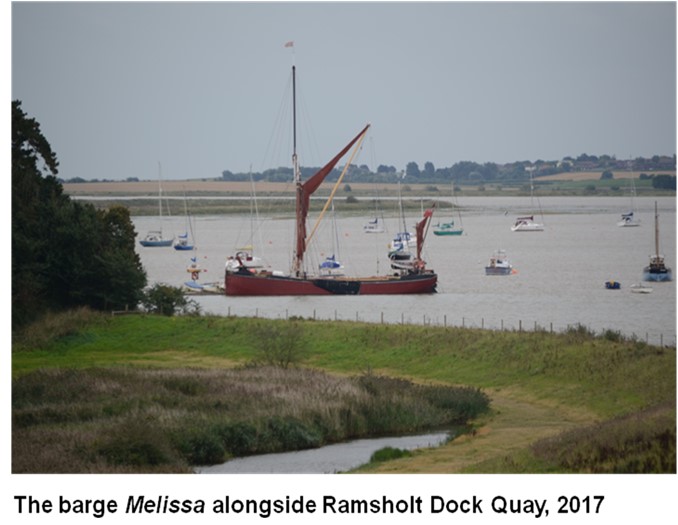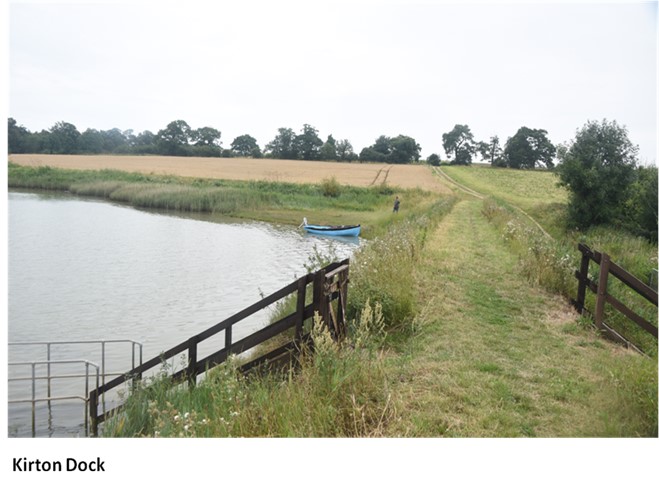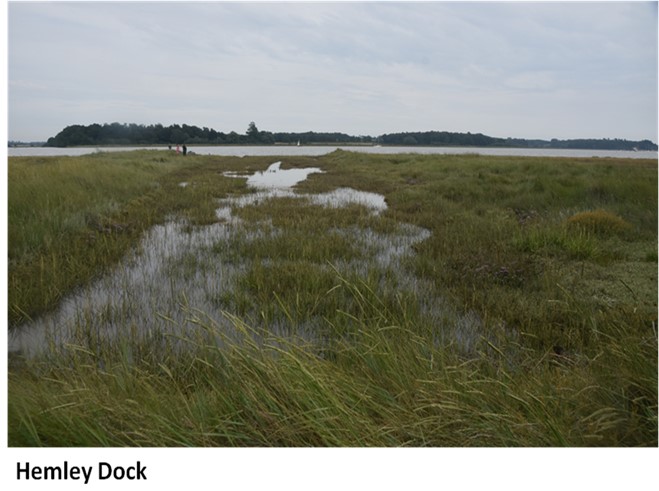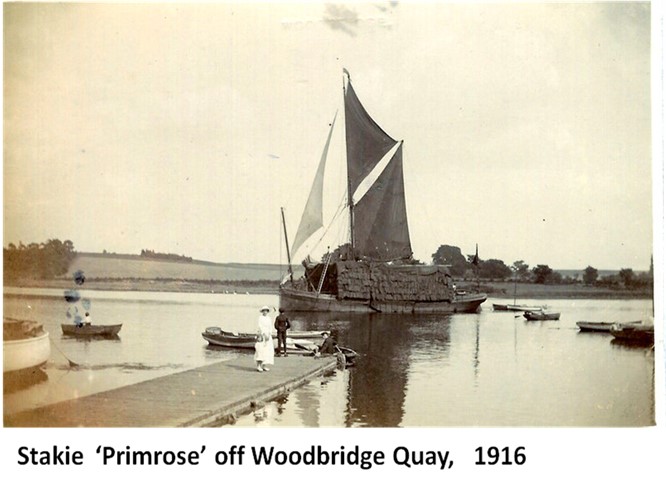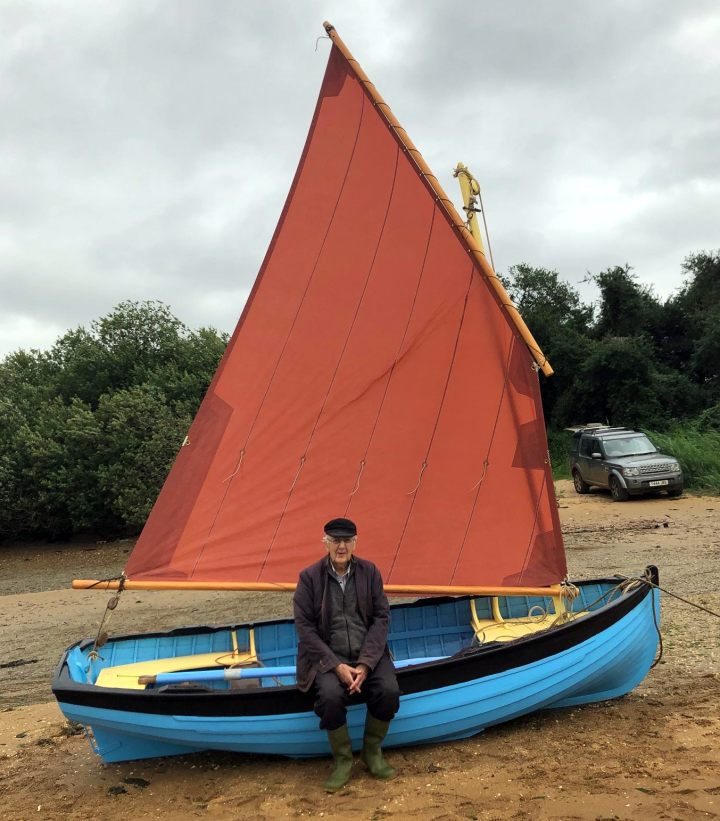by Robert Simper
Part 1: Bawdsey Ferry up to Hemley Dock
When I was young, in the early 1950s, there were still people who talked about the places where Thames barges loaded on the River Deben. Most of these were still clearly visible as loading wharves, but nearly seventy years later most of them have been reduced to just a few pieces of rotten wood sticking out of the mud.
Bawdsey Ferry Quay at the mouth of the Deben was the first place where barges came. The original quay at Bawdsey had been just down river from the present quay, but Sir Cuthbert Quilter had the present quay built to bring in coke and coal for the greenhouses and fires of Bawdsey Manor. When the Manor was built some of the building materials came through to Melton Station.
Moving up river the first real farm wharf was in Falkenham Creek. This had been a deep creek where large vessels landed goods but it had silted up. However, it was just right for the barges supplying food and bedding for horses on the London streets and milk, produced by the cows in the local barns, for the capital. The flat-bottomed Thames ‘stackie’ barges with their wide beams and low sides were just right for trading into farm wharves. Any enterprising farmer with safe access could either dig a dock or build a quay.
On the opposite side of the river is Ramsholt Dock which was busy in the late Victorian ‘stackie’ trade but it was already a port for the surrounding villages to bring in coal and take out grain and malt. The term Dock probably came from the draw docks on the Thames and was used in Essex and Suffolk to just mean anywhere a barge loaded. It could be a quay or a dock cut in the saltings.
The first barge, owned and crewed by Ramsholt men, on the Deben in the 1840s was the Maria. This was probably bought just as the coprolite pits were starting to be dug in the Sandlings villages. This was then shipped around to Ipswich to be turned into phosphate fertilizer.
The last cargoes to go out of Ramsholt were sugar beet, which was taken by barge to the Ipswich Factory in about 1926. This seems an awful lot of work just to move sugar beet to Sproughton, a journey that today can be done in an hour, but in the 1920s most goods in the countryside were moved in half ton horse drawn tumbrels or 2 ton ex-army lorries with solid tyres. A barge could carry over a hundred tons and could be sailed by two men and get to Ipswich in a day if the weather was fine. Then the beet was taken by rail to the sugar beet factory.
Back across the river at the head of Kirton Creek was Kirton Dock, built in 1880, for the local brickworks. From what is left of this dock it appears to have been part of the foreshore dug out and then given a hard bottom so that a barge could sit there, and horses and carts could come down beside the barge and load straight over the rail. Kirton Dock was last used by a farm barge in 1933 probably for carrying sugar beet to the Ipswich factory.
The ‘stackie’ barges going to the London wharves had mangolds loaded into the hold, to keep the weight low down, and hay or straw on deck stacked half way up the mast. The ‘stackie’ barges had more beam than other barges to give them stability. This was a specialist trade and they had iron bars up the side of the deck to hold the stack in place. Even then, if caught in bad weather, they occasionally lost the whole stack over the side before they got to the mouth of the Thames.
About 1897 Charles Cooper, a Hemley farmer, had a dock dug in the saltings so that two barges could be loaded at the same time. This dock had a well weighted buoy out in the river so that the barge could be hauled out when loaded. This anchor or block still appears to be there as fishing nets still get snagged at this spot.
Part 2: Stonner Point to Melton Dock
Going up river the next farm wharf was at Stonner Point, which is now little more than a few posts in the mud. This was built in about 1860 by Thomas Waller of Sutton Hall to ship out coprolite. It appears that when Waller built the quay the point was at the top of a creek, but since then the river has broken through.
The quay at Waldringfield was the only industrial place on the river. Frank Mason’s cement works sometimes had steamers and ketches loading cement for ports all around England. Mason owned six sailing barges which worked from here. The barges loaded cement to London and returned with chalk from the Thames that was burnt with Deben mud to create cement. Mason also owned a half size barge called Kingfisher and she went down to Hemley Point and men shovelled mud over the side into her hold. Over a period of about 25 years the Kingfisher took out about 4 hectares of saltings.
The creek at the lower end of Waldringfield beach is called Kingfisher Creek which could have been named after either the barge or the bird. It is believed that when the cement works closed the little Kingfisher became a houseboat at Pin Mill while the rest of the Mason barges were sold to Cranfield Bros, the Ipswich millers. Only one of these barges survives, the Orinoco, which is now based at Faversham, Kent.
Across the river is Methersgate Quay, which like Ramsholt Dock, is a nineteenth century triangular quay on the site of a late medieval wharf. The long quay front was for the barges to lie safely in the strong tides: also while the barge was being loaded the horses and carts had room to manoeuvre. Methersgate, Stonner and Ramsholt were built during the coprolite boom in the mid Victorian period.
Next up the river is Bantoft’s Dock, a cutting in the saltings just below Martlesham Creek which was used for loading hay and straw. Charles Bantoft who farmed at the near by Hill Farm cut this and no doubt the saltings belonged to him. It is said that the first cargo of sugar beet went out from there in about 1913. It is doubtful if the docks were used after World War I for the ‘stackie’ trade. These docks are now partly silted up, but the saltings are rising at the same rate as the sea level rise, so the level of the silt in the channels (docks) cut in between the saltings, although rising, remains below the level of the saltings.
I may be wrong but Martlesham Creek does seem to be the one Deben creek that did not have a barge-loading place. Probably the channel twisted so much that it was impossible to get an 80ft-loaded barge out of here. However off Kyson Point is the Kyson Pool, a piece of deep water (for the Deben) where Norwegian timber ships and other deep hulled vessels used to anchor, and part or all of their cargoes were discharged into two lighters and rowed up river.
The timber was taken to Brown’s timber yard which is now under part of Robertson’s Boatyard and coal from the Woodbridge schooners was taken to the Ferry Dock. The lighters were built and originally owned by Garrard at Lime Kiln Yard. They drifted up on the tide controlled by men with oars on the bow. One of these was called Deben and I don’t know if the other had a name.
Woodbridge, like most East Anglian small ports, dried out at low tide. After the railway came to Woodbridge it carried on being a port because of the sailing barges. Small steamers and even a few motor vessels did come up to Woodbridge with commercial cargoes until at least 1941. The picture shows the tiller steered barge Primrose off the Jetty at Woodbridge. The barge was taking hay from Ramsholt Dock to the Army camped at Woodbridge School. Astern are the barge boat and the pilot’s boat in about 1916.
From the Jetty going up river there were the Ferry Dock, Tide Mill Quay, The Pan where timber remained afloat, Lime Kiln Dock, Sun Wharf, Melton Hill Maltings Dock, Melton Dock and finally Wilford Bridge Wharf. Melton Dock is actually filled in and is under the workshop of Larkmans Boatyard. Just down river and slightly round the bend of Melton Dock there was also a brick jetty with a lane leading to it. This was sometimes referred to as The Pier and is now gone. It seems an unlikely place for barges to unload and we would welcome any information as to its real purpose.
George Arnott referred to a barge loading place on the Sutton shore called Hillen Hard after Robert Hillen of Ferry Farm who died in 1879. There is now no real trace of a hard good enough to load a barge along the Ferry Farm shore. The only place where this might have been is a man-made cut in the saltings opposite the Deben Yacht Club. It would, before silting, have to have been possible to take a small lighter loaded with coal in there.
Robert Simper
Robert Simper has lived on the Deben all this life. He was a founding member of the RDA and is now its president. Look out for his new book The Lost Village of Ramsholt, coming shortly from Creekside publishing.

